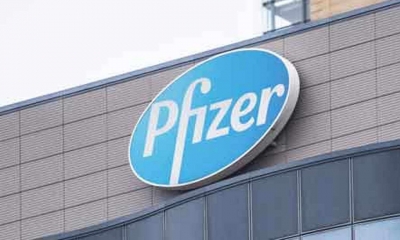NEW YORK– Pfizer Inc. (NYSE: PFE) announced today that the U.S. Food and Drug Administration (FDA) has approved BEQVEZ™ (fidanacogene elaparvovec-dzkt) for the treatment of adults with moderate to severe hemophilia B who currently use factor IX (FIX) prophylaxis therapy, or have current or historical life-threatening hemorrhage, or have repeated, serious spontaneous bleeding episodes, and do not have neutralizing antibodies to adeno-associated virus serotype Rh74var (AAVRh74var) capsid as detected by an FDA-approved test. BEQVEZ is a one-time treatment that is designed to enable people living with hemophilia B to produce FIX themselves rather than the current standard of care, which requires regular intravenous infusions of FIX that are often administered multiple times a week or multiple times a month.1,2
“Many people with hemophilia B struggle with the commitment and lifestyle disruption of regular FIX infusions, as well as spontaneous bleeding episodes, which can lead to painful joint damage and mobility issues,” said Adam Cuker, M.D., M.S., Director, Penn Comprehensive and Hemophilia Thrombosis Program. “A one-time treatment with BEQVEZ has the potential to be transformative for appropriate patients by reducing both the medical and treatment burden over the long term.”
Hemophilia B is a rare genetic bleeding disorder that prevents normal blood clotting because of a deficiency in FIX that causes those with the disease to bleed more frequently and longer than others.3,4 The standard of care for hemophilia B treatment is prophylactic infusions of FIX replacement therapy that temporarily replace or supplement low levels of blood-clotting factor.2,4 Despite prophylaxis and regular intravenous infusions, many people living with moderate to severe hemophilia B are at risk of spontaneous bleeding episodes.5,6,7 The current standard of care also places strain on healthcare systems’ budgets and resource utilization.6,8,9,10 According to the World Federation of Hemophilia, more than 38,000 people worldwide are living with hemophilia B.11
“This milestone is a testament to Pfizer’s continued effort to advance the standard of care for people living with hemophilia, with the delivery of a medicine that has the potential to offer both long-term bleed protection and value to the healthcare system because of its one-time administration,” said Aamir Malik, Chief U.S. Commercial Officer and Executive Vice President, Pfizer. “We are leveraging our expertise that comes with more than 40 years of experience in the hemophilia space, and are proactively working with treatment centers, payers, and the hemophilia community to appropriately help ensure the healthcare system is prepared to readily deliver BEQVEZ to the patients who can benefit from it.”
With BEQVEZ now approved for use, Pfizer is launching an innovative warranty program based on durability of patient response to treatment. The goal of the warranty is to provide greater certainty to payers, maximize access for eligible patients who receive BEQVEZ, and offer financial protection by insuring against the risk of efficacy failure.
“For people living with hemophilia, disease management can interfere with many aspects of their lives. A one-time infusion of BEQVEZ may allow eligible patients more time for the things they love,” said Kim Phelan, Chief Operating Officer, The Coalition for Hemophilia B. “We are excited to have BEQVEZ as a promising treatment option for eligible people living with hemophilia B. We look forward to learning more and celebrating with the community and with Pfizer at our annual conference that is currently taking place.”
BEQVEZ is currently under review with the European Medicines Agency (EMA), and the treatment recently received regulatory approval in Canada. In addition to BEQVEZ, Pfizer currently has two other Phase 3 programs investigating gene therapy in populations where there is a high unmet need: hemophilia A (giroctocogene fitelparvovec) and Duchenne muscular dystrophy (fordadistrogene movaparvovec). Additionally, a Phase 3 trial is investigating marstacimab, a novel, investigational anti-tissue factor pathway inhibitor for the treatment of people with hemophilia A and B with and without inhibitors. A Biologics License Application and European Marketing Authorization Application for marstacimab are currently under review with the FDA and EMA, respectively.
BEQVEZ is an adeno-associated virus (AAV)-based gene therapy designed to introduce in the transduced cells a functional copy of the FIX gene encoding a high-activity FIX variant. For eligible patients living with hemophilia B, the goal of this gene therapy is to enable them to produce FIX themselves via this one-time treatment rather than having to receive frequent infusions of FIX, as is the current standard of care.1,2,4
References:
1 Ohmori T, Mizukami H, Ozawa K, et al. New approaches to gene and cell therapy for hemophilia. J Thromb Haemost. 2015;13(Suppl 1): S133-142.
2 Furlan R, Krishnan S, Vietri J. Patient and parent preferences for characteristics of prophylactic treatment in hemophilia. Patient Prefer Adherence. 2015; 9:1687-1694.
3 Mayo Clinic. Hemophilia. August 2023. Available at: https://www.mayoclinic.org/diseases-conditions/hemophilia/symptoms-causes/syc-20373327. Last accessed: April 2024.
4 Centers for Disease Control and Prevention. What is hemophilia? October 2023. Available at: https://www.cdc.gov/ncbddd/hemophilia/facts.html#:~:text=Hemophilia%20is%20usually%20an%20inherited,can%20help%20to%20stop%20bleeding. Last accessed: April 2024.
5 Srivastava A, Santagostino E, Dougall A, et al. WFH Guidelines for the Management of Hemophilia, 3rd edition. Haemophilia. 2020;26 (Suppl 6):1-158.
6 Burke T, Asghar S, O’Hara J, et al. Clinical, humanistic, and economic burden of severe hemophilia B in the United States: results from the CHESS US and CHESS US+ population surveys. Orphanet J Rare Dis. 2021;16(1):143.
7 van Overbeeke E, Hauber B, Michelsen, et al. Patient preferences for gene therapy in haemophilia: Results from the PAVING threshold technique survey. Haemophilia. 2021;27(6):957-966.
8 Buckner TW, Bocharova I, Hagan K, et al. Health care resource utilization and cost burden of hemophilia B in the United States. Blood Adv. 2021;5(7):1954-1962.
9 Chen CX, Baker JR, Nichol MB. Economic burden of illness among persons with hemophilia B from HUGS Vb: examining the association of severity and treatment regimens with costs and annual bleed rates. Value Health. 2017;20(8):1074-1082.
10 O’Hara J, Hughes D, Camp C, et al. The cost of severe haemophilia in Europe: the CHESS study. Orphanet J Rare Dis. 2017;12(1):106.
11 World Federation of Hemophilia. Report on the annual global survey 2021. October 2022. Available at: https://www1.wfh.org/publications/files/pdf-2324.pdf. Last accessed: April 2024.



